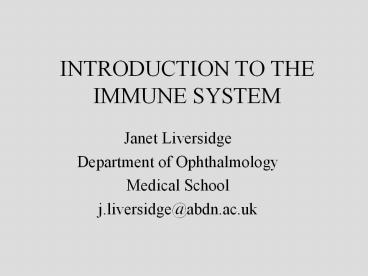INTRODUCTION TO THE IMMUNE SYSTEM - PowerPoint PPT Presentation
1 / 19
Title:
INTRODUCTION TO THE IMMUNE SYSTEM
Description:
INTRODUCTION TO THE IMMUNE SYSTEM. Janet Liversidge. Department of Ophthalmology. Medical School ... The course of a typical antibody response: ... – PowerPoint PPT presentation
Number of Views:71
Avg rating:3.0/5.0
Title: INTRODUCTION TO THE IMMUNE SYSTEM
1
INTRODUCTION TO THE IMMUNE SYSTEM
- Janet Liversidge
- Department of Ophthalmology
- Medical School
- j.liversidge_at_abdn.ac.uk
2
Innate and adaptive immunity
3
The course of a typical antibody response The
adaptive response takes 7-14 days to develop and
mount a specific, protective immune response
4
An infection, and the response to it can be
divided into stages and involves soluble
mediators and cells of the immune system
5
Circulating lymphocytes encounter antigen in
peripheral lymph nodes
The adaptive immune response develops in the
lymphoid tissues
Sentinel cells in the periphery pick up
pathogens and transport them to the draining
lymph node
6
- The immune response is dynamic, involving cells
re-circulating from the tissues via the
lymphatics and blood system - Innate immunity acts locally in the infected
tissue, - Adaptive immune responses develop in the lymphoid
tissues, - Effector cells multiply and migrate back to
tissue.
7
Cellular components of the immune system
8
Myeloid cells in innate and adaptive immunity
9
Phagocytic cells
Polymorphonuclear neutrophils
Blood monocytes
10
Phagocytosis
11
The mononuclear phagocyte system
12
Mobilisation of defensive components of innate
immunity
13
Macrophages and acute inflammation
14
B cells need T cell help to make antibody
Lymphocytes mediate adaptive (pathogen specific)
immunity each cell has a unique antigen receptor
15
Innate and adaptive (acquired) immunity are
integrated
16
The response to an initial infection occurs in
three phases innate, early induced, adaptive.
SUMMARY
17
Cells of the innate immune system, macrophages,
granulocytes, natural killer cells, immature B
cells
- Release of soluble components to opsinise
phagocytosis - Release of toxic granules to kill
micro-organisms, parasites or virally infected
cells - Release of soluble mediators to attract other
leukocytes to site of inflammation - Removal of dead or dying cells
- Transfer of infectious or toxic material to lymph
nodes to initiate adaptive immune response
18
Cells of the adaptive immune system Dendritic
cells, T and B lymphocytes,
- Lymphocytes are generated with unique antigen
receptors on their surface. - Dendritic cells (and macrophages) present antigen
to lymphocytes and provide activating signals - Lymphocytes undergo clonal expansion and migrate
back to area of infection as effector cells. - T cytotoxic cells selectively kill virally
infected cells - T helper cells selectively help B cells produce
large amounts of high affinity specific antibody.
- After infection, memory lymphocytes provide
protective immunity
19
Natural killer cells kill virally infected cells
Virally induced structures
IFN-g released by infected cell primesother
cells to kill it































